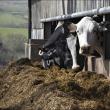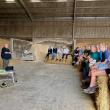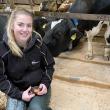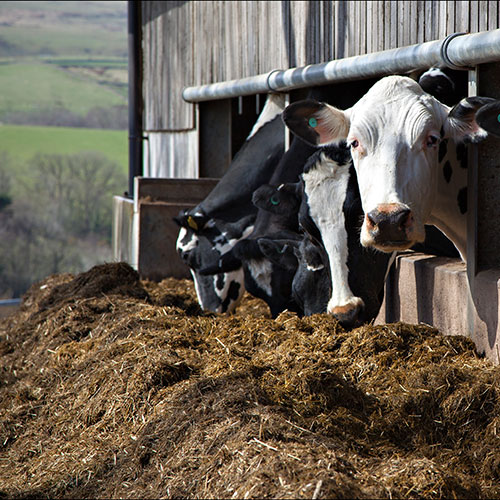Previous to Richard working with us we were struggling to get above 30/31 litres. Richard came in looked at the robot settings, the cow’s environment and nutrition. We saw an immediate response and an uplift in milk. We went from 31- 36 litres in very little time and it was down to Richard getting the diet right.
Should there be an extra silage cut?
As the silage season seems to be getting earlier each year should producers be wary of affecting the whole forage cycle by introducing another cut? British Dairying reports.
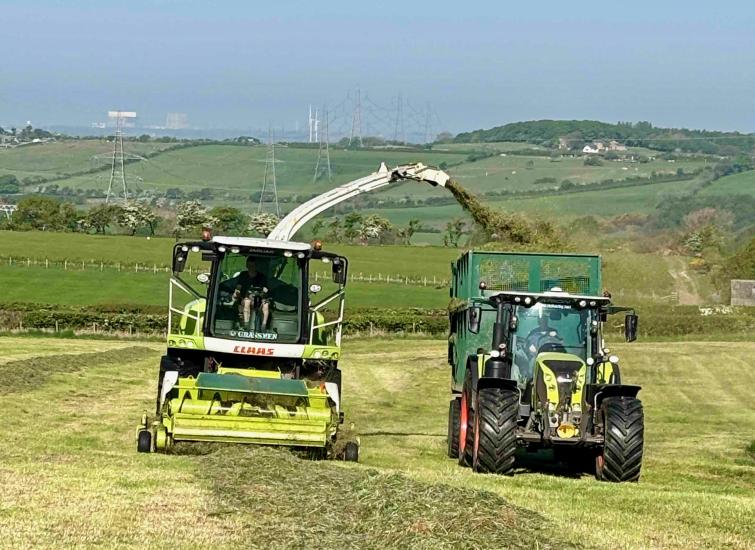
Over the last four to five years, the industry has started to see a trend towards an earlier first cut. Several factors may be driving this shift, no doubt, climate change being one of them. More importantly, harvesting earlier in the season effects the whole forage cycle. “One of the key contributors to this trend, is the shrinking period of zero grass growth, which is consistently decreasing across the UK, regardless of location,” notes Dr. David Davies at Silage Solutions.
So, should we all be taking an early first cut?
Taking an early first cut, needs to be thought about within the context of your forage strategy and shouldn’t just be about enabling more cuts throughout the season.
“The decision comes down to this - are we ready to take an early first cut when the grass is ready?” asks Eoghan Mullery Technical Director at Advanced Ruminant Nutrition. “We need to start with a clear objective: to produce high-quality silage and to produce enough of it. We should be aiming to reduce the variation between cuts and prioritise the quality of the final product to maximise the value of homegrown feeds, particularly grass silage.”
“Farmers need to be prepared to act early, if conditions allow. That means ensuring sheep are off the ground in good time, fertiliser is applied at the right stage, and slurry is fully absorbed, this is especially important on heavier soils.”
Dr Davies adds, “If ground conditions prevent you from getting out early, it’s worth reassessing how much slurry you’re applying, reducing the volume slightly might be a sensible option,” he advises. “On the other hand, if conditions are favourable and things are progressing well, it’s important to remember that grass needs those nutrients to thrive. For example, nitrogen and sulphur are essential not just for growth, but for protein production.”
From both a scientific perspective on silage production and a nutritional standpoint for the cow, Eoghan and David suggest that instead of strictly aiming for a 2-3 cut system or a full multi-cut approach, producers should simply focus on taking additional cuts when conditions allow. David prefers the term “opti-cut,” encouraging producers to think about the optimal time.
David explains, “The optimal time for cutting to feed a productive ruminant is when the grass is all leaf and immediately prior to seed stem emergence. In terms of how many cuts that is per season, it doesn’t really matter, so long as you are optimising the cut and producing quality silage,” explains Dr. Davies.
Forage Digestibility
“Cutting grass at optimum time increases digestibility of the crop”, explains Eoghan. “This gives silage lower levels of Neutral Detergent Fibre (NDF). This increased digestibility has two main benefits. The first is more energy and protein per mouthful and secondly, the opportunity for the cow to eat more mouthfuls, (if we let her).”
“A common misconception, and a real frustration of mine, is the belief that younger grass silage is harder to feed or doesn’t ‘stay in the cow’. Let’s simplify the science behind it -
as a grass plant matures, its cell and stem diameters increase, and the more lignified (woody) xylem tissue develops. As this happens the NDF digestibility decreases rapidly. So, the aim is to harvest before we lose digestibility.”
“For the rumen, this younger more digestible crop contains less NDF. NDF is not only a key energy source, but it also plays a vital role in rumen function.”
“If we take the example of a dairy cow diet containing 12kg dry matter of grass silage with an NDF level of 44%, this supplies 5,280 grams of forage NDF. If we harvest the grass crop at a more optimal stage and therefore a lower NDF level, let’s say at 40%, the same 12kg dry matter supplies 4,800 grams of forage fibre.”
“Each mouthful of this younger silage is more energy and protein dense. However, for the cow to fully benefit from that increased density, we must still provide at least the same total amount of NDF. Otherwise, we risk compromising rumen function. This can typically be seen on farm as an increased passage rate and in turn loose manure. However, this is NOT the fault of the forage. It’s our failure to supply the same level of NDF. To correct this, we’d need to provide 13.2kg of dry matter, at 40% NDF to deliver our original 5,280 grams of forage NDF.”
“As mentioned earlier, increasing the digestibility of the crop allows increased intakes. We can take advantage of this by increasing the forage DM offered. Of course, we must rebalance the rest of the diet to accommodate the additional higher energy and protein dense forage, but this shouldn’t mean we need to add extra physical or chemical fibre to ‘balance’ a younger grass silage. If our cows lose rumen fill and dung gets looser because we have offered a more digestible forage, I suggest the diet formulation is wrong. Rumens are designed to digest forage, but we must accommodate it correctly!”
So, what are the recommendations for a system with frequent cuts and younger grasses?
1. Whilst the fundamentals of silage making are the same, it’s important to adjust the wilting time to suit.
2. Younger grasses typically have a lower sugar content and higher levels of protein and minerals, which can make the fermentation process more challenging. Therefore, good ensiling management from field to sealing the clamp is required as well as the use of a good quality additive.
What makes a good additive?
A good additive is one that either applies 1 million homofermentative (produces lactic acid eg L. planatrum P. pentosaceus) Lactic Acid bacteria /g of forage, or controls the undesirable bacteria by chemically inhibiting their growth. This allows the lower sugar content to be used efficiently in the production of lactic acid to preserve the grass.
Additional considerations when cutting a younger crop are:-
- Adjust harvest timing to align with optimal grass growth
- Adapt the chop length depending on the crop’s dry matter (DM)
- DO NOT OVER COMPACT HIGH QUALITY GRASS as the lower NDF means fibre is easier to consolidate.
- Ideally don’t open a pit more than twice.
- When adding a second crop to the same pit don’t drive on the already fermented silage. Instead, fill with a layer of fresh layer of silage up to 30 inches deep from front to back and then resume normal fill.
Whether we call it “multi” “opti” or “one more” cut we know the season is getting earlier so if we don’t respond by cutting earlier and therefore likely cutting more often, our average grass silage quality will reduce.
“We’ve gained valuable insights into how to effectively feed these younger crops and the potential to increase income over all feeds is significant for both high yielding and more moderately yielding herds. Both approaches can maximise return on investment of any additional cuts but only if we understand how to feed these better crops and the key to this is understanding the relationship between NDF requirements and optimal rumen function!” concludes Eoghan.
〈 BACK

